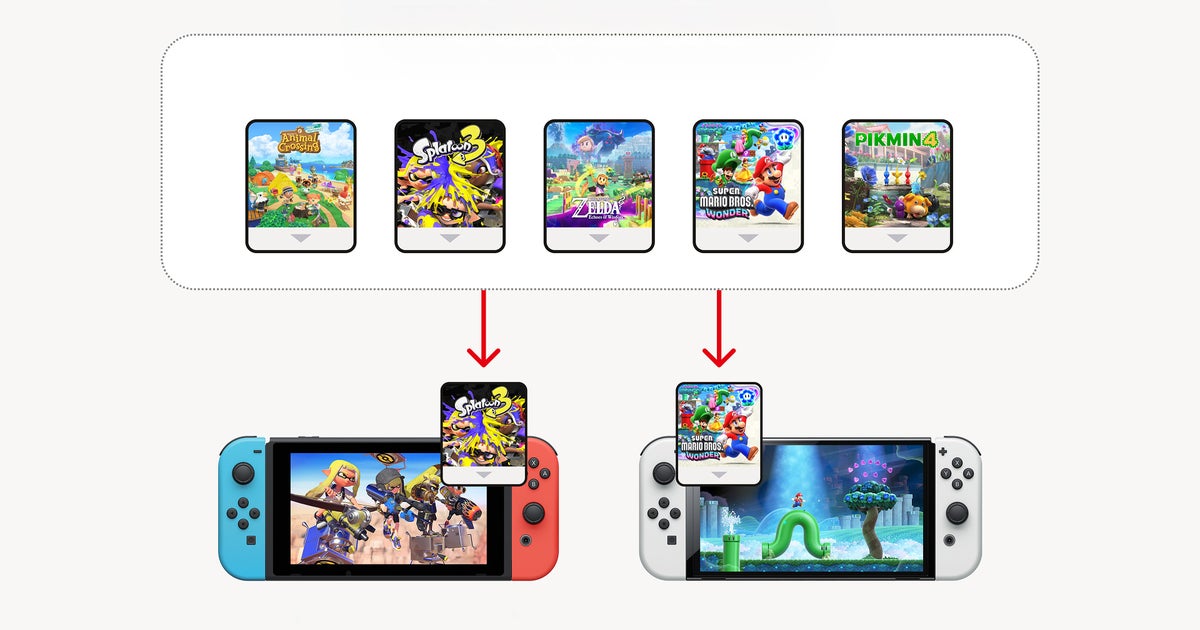Ahead of Wednesday’s Switch 2 reveal event, Nintendo announced a new feature for its Switch consoles: virtual game card. In short, you can now link multiple Switches together to share digital games, with a game that is ejected from the first unit then becoming playable on the second, without the hassle of setting “primary” and “non-primary” Switch devices. It could point towards Nintendo edging towards the same “adorably all digital” future espoused by Microsoft in leaked documents, but does it?
To discuss this, and the rest of the week’s tech news, Digital Foundry’s John, Alex and Oliver assembled for DF Weekly #207. The discussion kicks off 40 minutes into the episode, with our panellists concluding that this isn’t a move towards the digital-first approach taken by Microsoft and Sony, but rather a quality-of-life feature that comes into play just as owners of Switch consoles pick up a Switch 2.
So what’s the issue that Nintendo is trying to solve here? In short, right now you can nominate one Switch as your “primary” console, with all others being “non-primary”. The primary console can play all games offline, but non-primary consoles have to be online to run games – which is a pain if you wanted to play a digital game on a flight or anywhere else with limited connectivity.
- 0:00:00 Introduction
- 0:01:17 News 1: Nintendo Direct – Metroid Prime 4
- 0:11:02 Pokémon Legends: Z-A
- 0:22:08 Patapon, Everybody’s Golf, Tomodachi, Dragon Quest, Witchbrook, Shadow Labyrinth, Gradius, Marvel Cosmic Invasion
- 0:33:02 Switch 2 C button leak and Nintendo Today app
- 0:40:01 News 2: Nintendo introduces Virtual Game Cards
- 0:54:01 News 3: Switch 2 game rollout revealed?
- 1:00:33 News 4: Witcher 4, Intergalactic to arrive after 2026
- 1:09:51 News 5: Alex’s Nvidia driver woes
- 1:19:36 News 6: John’s GDC thoughts
- 1:32:44 Supporter Q1: What’s your favourite GPU of all time?
- 1:39:07 Supporter Q2: Will Valve release a Steam Deck 2 soon?
- 1:44:31 Supporter Q3: Should PC settings be changed to improve branding?
- 1:52:02 Supporter Q4: Could Xbox One have succeeded if it had been better introduced?
- 2:00:12 Supporter Q5: Is disc degradation a concern with Blu-ray media?
The new system seems fairly promising by comparison. Just as you can take out a physical Switch cartridge from your console and loan it to a friend or family member – or just put it in another Switch you own, eg travelling with a Switch Lite, – you’ll be able to “eject” a virtual cartridge from one device and “load” it onto another, using a bespoke menu. You need internet connectivity to load and eject, but after a game is loaded, it’s available thereafter regardless of conditions.
Family sharing also looks to have been improved in the new paradigm, with a simple screen for lending a game to a member of your (up to eight person) Nintendo family group. Family sharing comes with more stringent requirements though, with a 14 day use window – after which the transfer has to be reauthorised – and requiring both Switches to be within physical proximity for the transfer to work. However, you can still use the old family sharing system if you prefer.
The key thing here is that the virtual game card system lays the groundwork for a future where it’s likely that most Switch 2 purchasers will already have an original Switch console of some flavour lying around – and one that should remain useful even after the new hardware debuts, with Nintendo seeming likely to adopt a similar cross-generation strategy to that of Xbox and Microsoft with their ninth-generation consoles. Now transferring digital games between those two platforms becomes much more manageable, and you can easily pass off your old Switch to a friend or family member if you’re all-in on Switch 2.
Beyond this, it’s worth looking at the current state of affairs when it comes to physical retail presence. You’d have to say that Nintendo is leading in this aspect, certainly in their home market of Japan, with Microsoft having almost wholly exited the sector and Sony also shifting towards a more digital-first outlook.
That means that Nintendo has the most to lose from the switch to digital games, especially given their focus on an extremely wide target market that may be a little less comfortable with digital purchases – especially parents or grandparents buying games for children, a scenario where physical games have huge advantages. The new virtual game card uses a familiar metaphor that feels more intuitive at first blush than those of Nintendo’s rivals, but it’s hard to see the company abandoning its tried-and-tested approach to physical media any time soon.
The rest of the Direct is well worth watching, with coverage of some other interesting titbits from the Nintendo announcements – including the Switch 2’s C Button and potential game roll-out strategy. Elsewhere, Alex vents over the current state of Nvidia drivers, John shares his hands-on experiences from GDC and we have a series of cracking supporter questions, starting with what the best graphics card (and GPU generation) of all time is. It’s obviously the RTX 5090 in terms of raw performance, but our hosts have slightly more retro tastes.
Thanks to our supporters for submitting great questions as always, and if you’re interested in getting involved yourself – and getting access to high-quality video downloads of everything we do, exclusive production notes each week and plenty more, check out the DF Supporter programme on Patreon!

